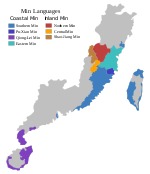Yongchun dialect
Appearance
| Yongchun | |
|---|---|
| 永春话 / 永春話 | |
| Native to | People's Republic of China Republic of China Malaysia Singapore Indonesia Philippines Brunei Myanmar |
| Region | Yongchun County, Quanzhou, Southern Fujian province. |
Early forms | |
| Language codes | |
| ISO 639-3 | – |
| Glottolog | None |
The Yongchun dialect (simplified Chinese: 永春话; traditional Chinese: 永春話; Pe̍h-ōe-jī: Éng-chhun-ōe) is a dialect of the Hokkien language mostly spoken in Yongchun County of Quanzhou city in Southern Fujian Province, China. It belongs to the Quanzhou Hokkien branch.
Because most of the early immigrants to southern Malaysia were Quanzhou people, minority Quanzhou Yongchun people in Klang spoke the Yongchun dialect, and the other are assimilation by Tung'an Dialect.
Phonology
[edit]The table below contains all the finals of the Yongchun dialect.[4]
| i 支,資 | a 飽,爸 | e 袋,下 | u 有,龜 | o 無,道 | ɔ 故,古 | ɯ 豬,去 | ə 火,灰 |
| ia 寫,奇 | iu 丑,休 | io 少,笑 | iou 張 | iau 了,刁 | ieʔ 滅,别 | au 流,交 | ou 河 |
| im 心,金 | am 含,街 | əm 欣,森 | iam 減,欠 | m 毋,梅 | in 新, 品 | an 安,干 | un 分,雲 |
| ian (iɛn) 電,現 | uan 權 | iŋ 朋,丁 | aŋ 紅,東 | ɔŋ 講,仿 | iaŋ 響,誰 | iɔŋ 忠,央 | uaŋ 風 |
| it 筆,必 | at 插 | ãt 炸,閘 | uat 法,髮 | uet 八,拔 | iat (iɛt) 揭,切 | ət 說 | |
| ak 迫,白 | ɔk 各,駁 | iak 頁,白 | iɔk 著,咯 | uak 潑,脱 | uik 突,率 | ŋ 光,床 | |
| ip 立,吸 | ap 答,朵 | iap 粒,澀 | ui 桂,貴 | ua 大,刮 | ue 多,花 | uai 怪,歪 | |
| ĩ 圓,平 | ã 三,罵 | ẽ 妹,奶 | ãi 耐,唉 | iã 走,驚 | uĩ 关,千 | uã 官,汗 | uãi 彎 |
| iʔ | aʔ | eʔ | uʔ | əʔ | ɯʔ | iaʔ | ioʔ |
| ãuʔ | ɔʔ | ŋ̍ʔ | iɔʔ | ueʔ | iãuʔ |
Notes
[edit]References
[edit]- ^ Mei, Tsu-lin (1970), "Tones and prosody in Middle Chinese and the origin of the rising tone", Harvard Journal of Asiatic Studies, 30: 86–110, doi:10.2307/2718766, JSTOR 2718766
- ^ Pulleyblank, Edwin G. (1984), Middle Chinese: A study in Historical Phonology, Vancouver: University of British Columbia Press, p. 3, ISBN 978-0-7748-0192-8
- ^ Hammarström, Harald; Forkel, Robert; Haspelmath, Martin; Bank, Sebastian (2023-07-10). "Glottolog 4.8 - Min". Glottolog. Leipzig: Max Planck Institute for Evolutionary Anthropology. doi:10.5281/zenodo.7398962. Archived from the original on 2023-10-13. Retrieved 2023-10-13.
- ^ "闽南永春方言语气词及研究". Fujian Normal University (福建师范大学).

